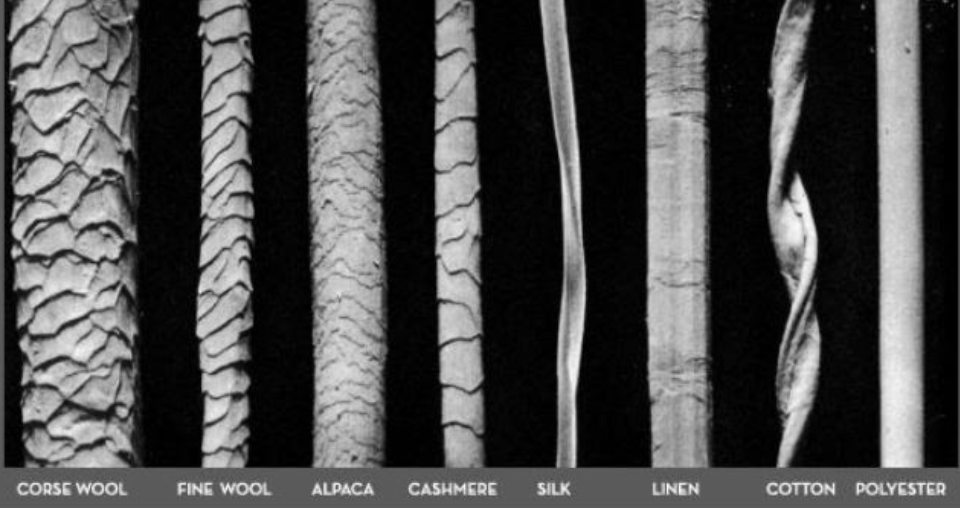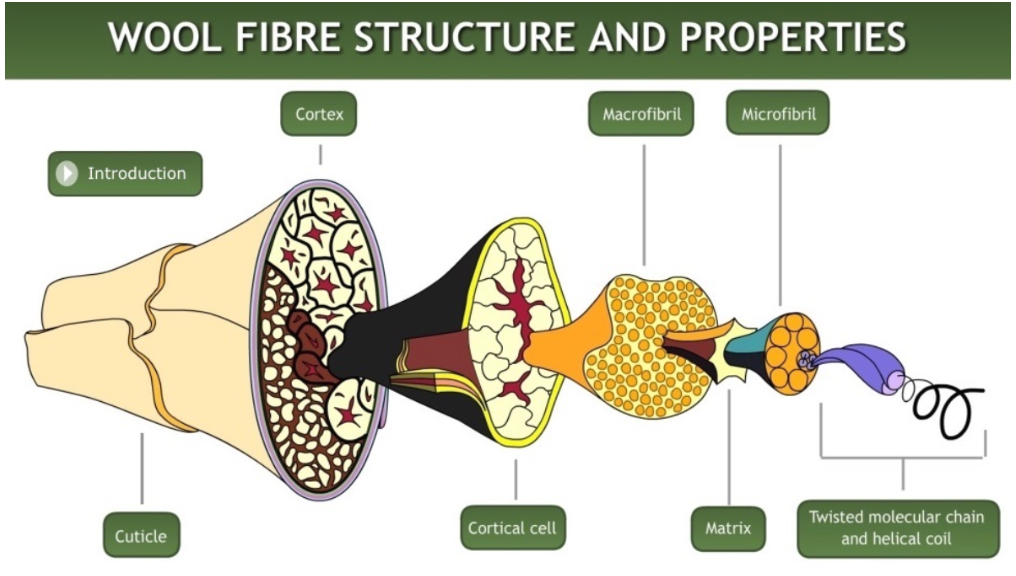Someone recently highlighted an interesting fact to us. If (insert big company name here e.g. 3M or Dupont) made a fiber that was renewable, managed moisture, purified the air and compostable everyone would buy it. Well, guess what…..you can. That is what a coarse wool fiber does all day, everyday.
How is that possible?
Simple. For the past 10,000 years, wool has evolved in nature’s R&D department, not a lab. It is designed to protect animals from all elements – hot and cold; wet and dry. The result is a fiber far superior to what we could have created in a lab over the last 100-150 years. Shocker!
As is clear in these images there is a lot going outside and inside a coarse wool fiber. Conversely, there is much less happening with a silk or cotton fiber, and even less with a synthetic, polyester one.
Wool inherently :
- Manages moisture – without concern for mold
- Insulates against all elements
- Absorbs sound
- Filters the air – amino acids bond with formaldehyde, nitrogen oxide and sulphur dioxide.
- Naturally self-extinguishes
- Fully composts
So How and Why does Wool do this all? The simple answer lies in the complexity of the wool fiber.
 The outside of the wool fiber is comprised of overlapping scales called cuticle cells. The cuticle cells provide a strong exterior, protecting wool from damage. The cells have a waxy coating, lanolin, which makes wool water repellent but they also have tiny pores allowing vapour to pass in and out of the fiber. This is how we get moisture management or hygroscopic properties from wool. It absorbs and desorbs moisture, creating a dynamic cycle which keeps it’s environment dry (your skin, the air in your house) while also sustaining the integrity of the fiber. No wet slumping here!
The outside of the wool fiber is comprised of overlapping scales called cuticle cells. The cuticle cells provide a strong exterior, protecting wool from damage. The cells have a waxy coating, lanolin, which makes wool water repellent but they also have tiny pores allowing vapour to pass in and out of the fiber. This is how we get moisture management or hygroscopic properties from wool. It absorbs and desorbs moisture, creating a dynamic cycle which keeps it’s environment dry (your skin, the air in your house) while also sustaining the integrity of the fiber. No wet slumping here!
A look inside the wool fiber is equally revealing
In an ingenious display of evolution the inside of a wool fiber, the cortical cell, is actually arranged in two distinct halves. These two halves respond differently to the environment which makes the wool fiber bend or crimp. This crimp is crucial because it creates bulk and traps a large volume of air between the fibers. And this makes for a good insulator. The crimp along with the aforementioned cuticle cells also prevent dirt from entering the fiber. Clean and warm!
 Looking even further into the fiber we see inside the cortical cell a spring-like structure, which gives wool its flexibility and elasticity. Example… a wool fiber can be bent on itself over 20,000 times! Further, this spring-like structure is surrounded by a matrix containing high sulfur proteins that readily absorb water molecules… which again helps with moisture management.
Looking even further into the fiber we see inside the cortical cell a spring-like structure, which gives wool its flexibility and elasticity. Example… a wool fiber can be bent on itself over 20,000 times! Further, this spring-like structure is surrounded by a matrix containing high sulfur proteins that readily absorb water molecules… which again helps with moisture management.
The interior composition of wool also explains it’s resistance to fire and it’s ability to self extinguish. Wool has high nitrogen and water content so it needs higher levels of oxygen to burn than the surrounding environment provides. In addition, wool’s cross-linked cell membrane structure will swell when heated to the point of combustion, forming an insulating layer that prevents the flame spread. This also means that wool produces less smoke and gas than synthetic fibers and synthetic insulation for that matter!
Keratins are Key
Sheep’s wool is 97% keratins (think hair, nails). What’s crucial about keratins is that they contain amino acids which bind with harmful chemicals like formaldehyde, nitrogen oxide and sulphur dioxide. In another ingenious evolutionary development, they also irreversibly bond with these chemicals.
And finally a word on sound absorption, a key attribute of wool insulation. Again, owing to the unique structure of the fiber, wool is elastic (returns to it’s original solid shape) and has some viscous properties (behaves like a liquid) so we describe it as viscoelastic. What’s amazing about viscoelastic materials is that they absorb the energy of sound waves and then dissipate this energy outward. Translation – wool insulation creates a quiet living space in a completely natural way.
These are facts, not marketing speak or conjecture.
The science and data is there to support the high-integrity characteristics of a wool fiber. Admittedly, much of the information is spread across various industries and associated applications. Commercial and residential insulation comes up a bit short in absolute terms even though relative ones apply. We are changing that part of the game as we embark on a life cycle analysis, environmental product declaration and rigorous testing relative to moisture challenges in the built environment.
We will share updates on this process as we go. Stressing the wildly dynamic inherent characteristics seemed like a relevant place to start!
.

Well done. I’ve written on this subject often for our wool carpeting and could not have said it any better. Same wool. Different application. Keepin’ it sustainable!
I love wool! I cloth diapered all my kids, and used merino wool for diaper covers to control moisture. The skin can breathe, it’s antimicrobial, and it’s perfect for diaper clothing. I totally fell in love with it! Thank you for making wool available to do its job in another way that produces comfort for the mind and body. Thank you!